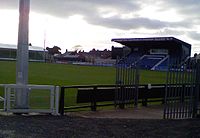
The Victoria Ground was the home ground of Stoke City from 1878 until 1997, when the club relocated to the Britannia Stadium after 119 years. At the time of its demolition it was the oldest operational ground in the Football League.
The Hawthorns is an all-seater football stadium in West Bromwich, West Midlands, England, with a capacity of 26,688. It has been the home of Championship club West Bromwich Albion since 1900, when it became the sixth ground to be used by the club. The Hawthorns was the first Football League ground to be built in the 20th century, opening in September 1900 after construction work took only 4 months. The official record attendance at The Hawthorns stands at 64,815, set in 1937.

Tannadice Park, usually referred to as Tannadice, is a football stadium in Dundee, Scotland. It is the home ground of Dundee United F.C., who have played at Tannadice since the club was founded as Dundee Hibernian in 1909. The stadium has been all-seated since 1994 and has a capacity of 14,223. It is located only 200 yards from Dundee F.C.'s stadium, Dens Park; the two are the closest senior football grounds in the UK.

Fratton Park is a football ground in Portsmouth, Portsea Island, England and is the home of Portsmouth F.C. Fratton Park's location on Portsea Island is unique in English professional football, as it is the only professional English football ground not located on the mainland of Great Britain. Fratton Park has been the only home football ground in Portsmouth F.C.'s entire history.

Loftus Road, currently known as MATRADE Loftus Road Stadium for sponsorship reasons, is a football stadium in Shepherd's Bush, London, England, which is home to Queens Park Rangers Football Club.
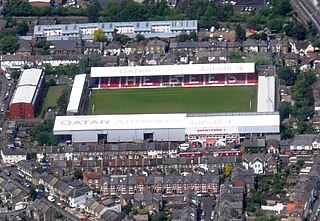
Griffin Park was a football ground in Brentford in the London Borough of Hounslow, England. It was the home ground of Brentford F.C. from its opening in September 1904 to August 2020. The ground was in a predominantly residential area and was known for being the only English league football ground to have a pub on each corner. The ground's name referred to the griffin featured in the logo of Fuller's Brewery, which at one point owned the orchard on which the stadium was built.

Headingley Stadium is a stadium complex in Headingley, Leeds, West Yorkshire, England. Linked by a two-sided stand housing common facilities, it comprises the two following separate grounds: Headingley Cricket Ground and Headingley Rugby Stadium.
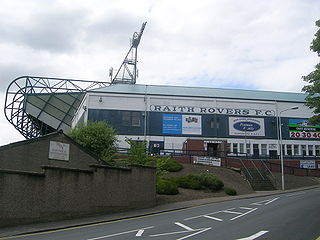
Stark's Park is a football stadium in Kirkcaldy, Scotland. It is the home ground of Raith Rovers, who have played there since 1891. The ground has an all-seated capacity of 8,867.

Newport Stadium, also known as Spytty Park, is an association football, rugby and athletics stadium in Newport, South Wales. It is the home of Gwalia United FC, Newport City Football Club, Newport RFC and Newport Harriers Athletic Club. It was previously also used for home matches by Newport County and Albion Rovers football clubs. Newport County continue to use the stadium as a base for youth teams and senior squad training.

Stafford Rangers Football Club is a semi-professional English football team from Stafford which plays in the Northern Premier League Division One West.
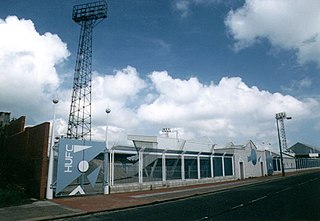
Victoria Park is a football ground in Hartlepool, County Durham, England, which is the home of National League club Hartlepool United.
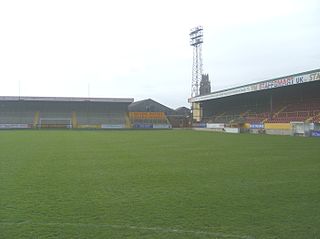
York Street, also known as The Jakemans Stadium for sponsorship purposes, is a football stadium in Boston, England, and was the former home of Boston United. Originally called Shodfriars Lane, football was first played on the site since the late 19th century by a variety of Boston teams, but it was only used by Boston United since 1933. In the late 1970s the ground was rebuilt. Although the ground currently had a maximum capacity of 6,643, the record crowd was 11,000 against Derby County. 10 further attendances of more than 8,000 are on record. Boston United left the York Street ground at the end of the 2019/20 season. In August 2021 Railway Athletic FC moved into the stadium.

London Road, currently known as the Weston Homes Stadium for sponsorship reasons, is a multi-purpose stadium in Peterborough, England. The stadium is in Fletton, south of the River Nene. It is currently used mostly for football matches and is the home ground of Peterborough United. The stadium holds 13,511 and was built in 1913, though the present ground bears no resemblance to the original following several periods of redevelopment.

Solitude is a football stadium in Belfast, Northern Ireland. It is the oldest football stadium in Ireland, and the home ground of Ireland's oldest football club, Cliftonville. The stadium holds 6,224, but is currently restricted to 2,530 under safety legislation.

Llanelian Road is a multi-use stadium in Old Colwyn, North Wales and also known as the 4 Crosses Construction Arena for sponsorship purposes. It is currently used mostly for football matches and is the home ground of Colwyn Bay F.C. of the Cymru North.
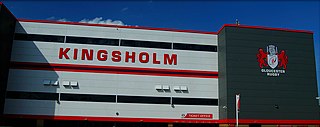
Kingsholm Stadium is a rugby union stadium located in the Kingsholm area of Gloucester, England, and is the home stadium of Gloucester Rugby. The stadium has a capacity of 16,115. It is sometimes nicknamed 'Castle Grim', after the estate where the stadium is built. The new main grandstand, opened in 2007, is an all-seated 7,500 capacity stand along the south touchline. It is currently sponsored by Malvern Tyres.

Palmerston Park is a football stadium on Terregles Street in Dumfries, Dumfries and Galloway, Scotland. It is the home ground of Scottish League One club Queen of the South, who have played there since 1919. South of Scotland League club Heston Rovers have shared Palmerston since 2013. The stadium has a capacity of 8,690 of which 3,377 are seats.

The Victoria Stadium was a football stadium in Wincham, Northwich in the county of Cheshire, England, and was home to Northwich Victoria.

Somerset Park is a football stadium located in Ayr, South Ayrshire, Scotland. It has been the home of Scottish Championship team Ayr United since the club was founded in 1910. Prior to that, it was the home ground of Ayr, who merged with Ayr Parkhouse to form Ayr United. The 10,185 capacity stadium was designed by renowned football stadium architect Archibald Leitch.

Highbury Stadium is a football stadium in Fleetwood, Lancashire, England, with Wyre Borough Council as the landlords. It is the home ground of Fleetwood Town and was also used for home matches by Blackpool F.C. reserves until 2014. As of the opening of the new Parkside Stand on 16 April 2011, the ground has a capacity of 5,327.
